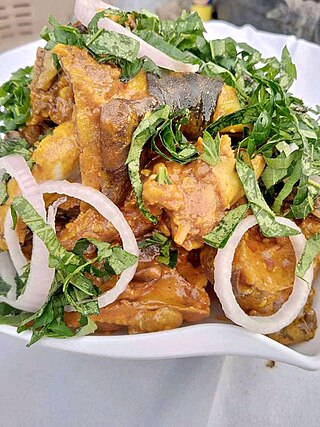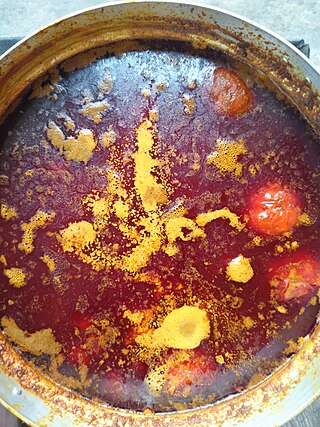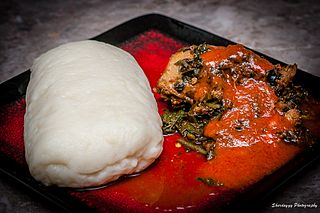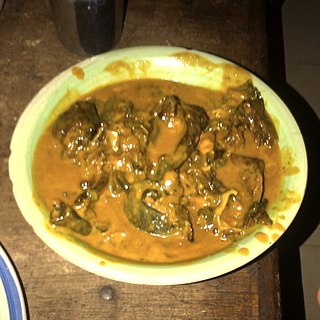
Nkwobi is a delicacy commonly found in [ clarification needed ] restaurants, it is otherwise known as nkwobi. The cuisine is common among the people of Igbo ethnic group. [1] [2] it is a soup made up of cuts from cow feet. [3]

Nkwobi is a delicacy commonly found in [ clarification needed ] restaurants, it is otherwise known as nkwobi. The cuisine is common among the people of Igbo ethnic group. [1] [2] it is a soup made up of cuts from cow feet. [3]
The ingredients and spices needed to make the Nigerian dessert include palm oil, kaun also known as potash, Calabash nutmegs, utazi leaves, pepper, onion etc. An alternative to potash is ngu, spinach can be used instead of utazia if not available for use. [4] [5] [6] [7] Nkwobi is sometimes prepared made at home, even though it is commonly found in restaurants. The soup is made from cow feet boiled with onion and variety of spices [8] [9] Potash mixture is added to palm oil, stirred until yellow and thickened. Crayfish, Calabash nutmeg and grinded pepper are added afterward. [10] The cooked cow feet into the oil mixture and stirred gently to avoid burning. [11] [12]

Moroccan cuisine is the cuisine of Morocco, fueled by interactions and exchanges with many cultures and nations over the centuries. Moroccan cuisine is usually a mix of Arab, Berber, Andalusi, and Mediterranean cuisines, with minimal European and sub-Saharan influences. Like the rest of the Maghrebi cuisine, Moroccan cuisine has more in common with Middle Eastern cuisine than with the rest of Africa.

Vietnamese cuisine encompasses the foods and beverages of Vietnam. Meals feature a combination of five fundamental tastes : sweet, salty, bitter, sour, and spicy. The distinctive nature of each dish reflects one or more elements, which are also based around a five-pronged philosophy. Vietnamese recipes use ingredients like lemongrass, ginger, mint, Vietnamese mint, long coriander, Saigon cinnamon, bird's eye chili, lime, and Thai basil leaves. Traditional Vietnamese cooking has often been characterised as using fresh ingredients, not using much dairy or oil, having interesting textures, and making use of herbs and vegetables. The cuisine is also low in sugar and is almost always naturally gluten-free, as many of the dishes are rice-based instead of wheat-based, made with rice noodles, papers and flour. Vietnamese cuisine is strongly influenced not only by the cuisines of neighboring China, Cambodia and Laos, but also by French cuisine due to French colonial rule over the region from 1887 to 1954.

Tripe is a type of edible lining from the stomachs of various farm animals. Most tripe is from cattle, pigs and sheep.

Offal, also called variety meats, pluck or organ meats, is the internal organs of a butchered animal. The word does not refer to a particular list of edible organs, and these lists of organs vary with culture and region, but usually exclude skeletal muscle. Offal may also refer to the by-products of milled grains, such as corn or wheat.

Trinidad and Tobago has a unique history and its food is influenced by Indian-South Asian, West African, Creole, European, American, Chinese, Amerindian, and Latin American culinary styles. Trinidadian and Tobagonian food is dominated by a wide selection of dishes, most notably, doubles, roti, pelau, callaloo and curried crab and dumplings. Trinidad and Tobago is also known for its prepared provisions, such as dasheen, sweet potato, eddoes, cassava, yam, soups and stews, also known as blue food across the country. Corresponding to the Blue Food Day event held annually in Trinidad and Tobago.

Àmàlà is a staple swallow food originating from Nigeria popularized by the Yoruba ethnic group of Southwestern Nigeria and other parts of Yorubaland. It is made of yam, cassava flour, or unripe plantain flour. Tubers of yams are peeled, sliced, cleaned, dried and then ground into flour. It is also called èlùbọ́. Yams are white in colour but turn brown when dried which gives àmàlà its colour. It is a popular side dish served with ewédú and gbẹ̀gìrì, but is also served with a variety of other ọbè(soups), such as ẹ̀fọ́, ilá, and ogbono.

Ghanaian cuisine refers to the meals of the Ghanaian people. The main dishes of Ghana are centered around starchy staple foods, accompanied by either sauce or soup as well as a source of protein. The primary ingredients for the vast majority of soups and stews are tomatoes, hot peppers, and onions. As a result of these main ingredients, most Ghanaian soups and stews appear red or orange.

Fried plantain is a dish cooked wherever plantains grow, from West Africa to East Africa as well as Central America, the tropical region of northern South America and the Caribbean countries like Haiti to Cuba and in many parts of Southeast Asia and Oceania, where fried snacks are widely popular. In Indonesia it is called gorengan. It is called dodo in Yoruba in South West Nigeria, otherwise known as simply fried plantain in other parts of Nigeria. Kelewele is a fried spicy plantain or can be fried as a side dish for Red Red and fish stew in Ghana.

Nigerian cuisine consists of dishes or food items from the hundreds of Native African ethnic groups that comprises Nigeria. Like other West African cuisines, it uses spices and herbs with palm oil or groundnut oil to create deeply flavored sauces and soups.

The cuisine of Algeria is influenced by Algeria's interactions and exchanges with other cultures and nations over the centuries. It is based on both land and sea products. Conquests or demographic movement towards the Algerian territory were two of the main factors of exchanges between the different peoples and cultures. The Algerian cuisine is a mix of Arab, Berber, Turkish and French roots.

Isi ewu is a traditional Igbo dish that is made with a goat's head.

I Love Bacon! is a cookbook with over fifty recipes devoted to bacon and bacon dishes, many of them from celebrity chefs. The book was written by Jayne Rockmill and photography was provided by Ben Fink. Broken down into eight sections, the book covered how to make homemade bacon and moves onto "brunch" and "small bites" before covering soups, salads and sides, pasta, fish, meat, and desserts. I Love Bacon! was published in October 2010 by Andrews McMeel Publishing and met with favorable reviews for its unique dishes and helpful culinary tips for novices.

Palm nut soup or banga is a soup made from palm fruit common in the Cameroonian, Ghanaian, Nigerian, Democratic Republic of Congo and Ivorian communities. The soup is made from a palm cream or palm nut base with stewed marinated meats, smoked dried fish, and aromatics. It is often eaten with starch, fufu, omotuo, banku, fonio, or rice. The use of the palm fruit in cooking is significant in Ivorian, Cameronian, Nigerian, Ghanaian, Liberian and other West and Central African cuisine.

Peppersoup is a soup from parts of West Africa, notably Nigeria, made using various meats or fishes, chili peppers, scent leaves and calabash nutmeg as the primary ingredients. It is a spicy soup that has a light, watery texture. Despite its name, the soup is not necessarily defined by a pepper-forward flavor profile, that is, the flavors are much more complex, with nutty, bitter, woodsy, and floral notes, as well as warmth. It is considered to be a delicacy by some people in Western Africa, and some West Africans believe that the soup has some basic medicinal qualities.

Goat meat pepper soup, also referred to as nwo-nwo, ngwo-ngwo, and goat pepper soup, is a soup in Nigeria. Goat meat is used as a primary ingredient, and some versions may use crayfish. For variations boiled yams, potatoes, or plantains may be added. Versions of the soup may be spicy and hot. The soup is always served hot and is made with a blend of different spices which gives an intense spiciness and flavor to the soup. The dish has been described as being the most popular out of all the Nigerian pepper soups. It is a light soup that is often prepared without the use of oil, and may also be drunk in the style of a beverage. Owing to the ‘light’ texture of the soup, it is typically eaten alone but it can be accompanied by a side-dish known as agidi. White rice is also a common side-dish served with goat meat pepper soup. It has been described as pairing well with palm wine and beer.

Ofada rice is a Yoruba dish. It is the name of an indigenous rice from a small community called Ofada, located in the Obafemi Owode Local Government Area of Ogun State. It is not exclusively grown in the community, but it is an indigenous rice grown in southwest Nigeria but named after the Ofada community. It is used in making a variety of dishes. Ofada rice are mostly blends, and some of the rice varieties in the blends are not indigenous to Africa; however, they usually also contain African rice. It is grown almost exclusively in Ogun State, a state in southwestern Nigeria. Ofada rice is grown on free-draining soil where the water table is permanently below the root of the plant.

Àbùlà is a soup of Yoruba people from Western Nigeria. It is typically eaten together with amala, but can be eaten with other swallow foods. Abula literally means a mixture of soups but is mostly associated with a mixture of gbegiri, ewedu and ọbẹ̀ata (stew).

Pounded yam or Iyán (Yoruba) or Ruam-Yo (Tiv) is a Nigerian swallow food native to the Yoruba, Igbo Edo, Tiv and Ebira ethnic groups. It is a traditional food prepared by pounding boiled yam with a mortar and pestle. Pounded yam is similar to mashed potatoes but heavier in consistency. It is a smooth and tasty delicacy traditionally eaten with the hands.

Owo is a soup eaten in the south-central region of Nigeria. It is common among the itsekiri, Urhobo and Isoko such as. The soup is made with garri soaked in water after palm oil and potash mixture has been added. It is traditionally served at weddings in the Delta State; its absence at a wedding celebration is considered insulting to guests. It is also served at other traditional celebrations. It is especially important among the itsekiri, Urhobo, and Isoko people.
Mahogany Seed Soup (Ofe Akparata) is a soup made from Mahogany seed traditional known as Akparata among the Igbo tribe. The soup originates from the Eastern part of Nigeria and it is a favourite dish among the Enugu indigenes. The Mahogany seed is widely used as a thickener used in soups and other dishes, besides using it as a thickener it can also be used in making the sauce used in the preparation of Cowleg or Goatleg Nkwobi and Abacha.